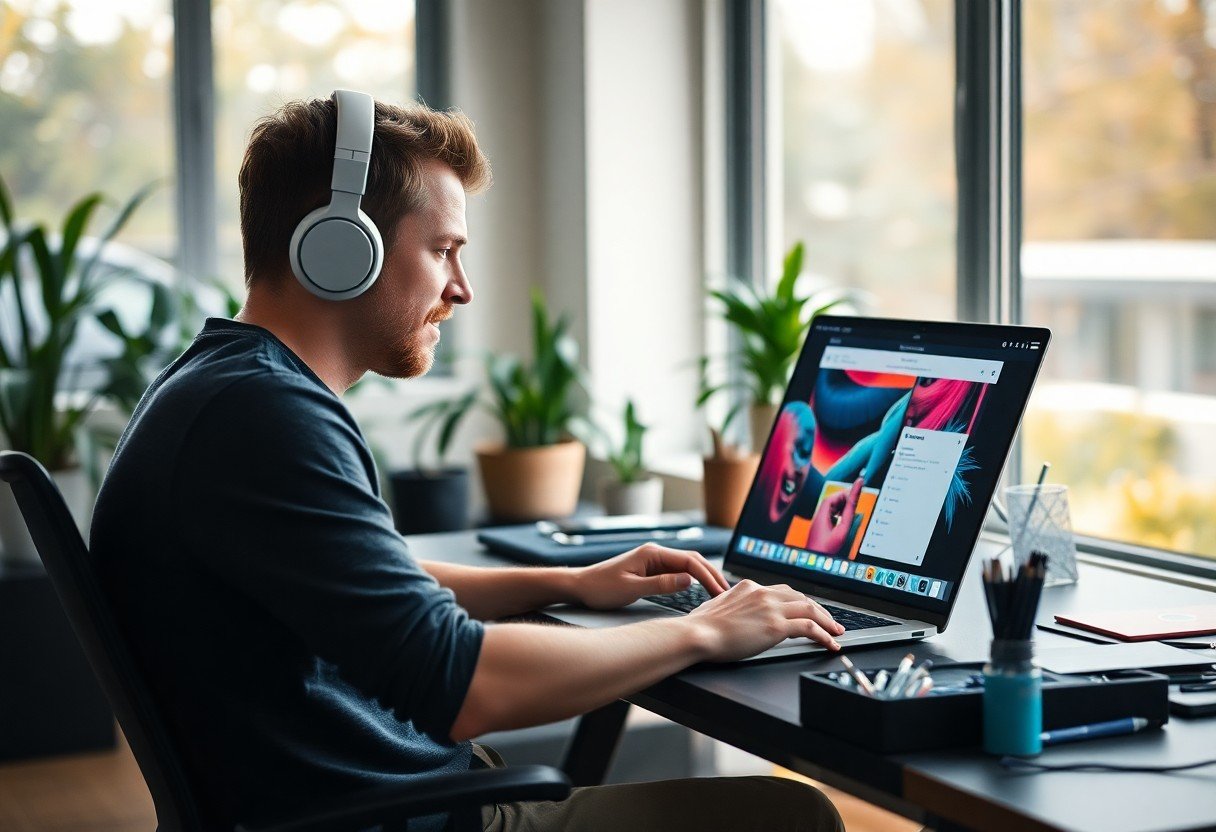Headspace has been a game-changer in my creative process. As I navigate the challenges of brainstorming and executing ideas, I find that utilizing mindfulness techniques helps me harness my thoughts more effectively. By taking just a few minutes to meditate, I can clear mental clutter and boost my focus and productivity. This practice allows me to approach my work with a fresh perspective, making it easier to tap into my innate creativity. Join me as I explore how you can leverage Headspace for your own creative pursuits.
Jesper Jacobi’s Creative Landscape
Jesper Jacobi’s creative process thrives in an environment where inspiration can be seamlessly blended with structured focus. His workspace is often a reflection of his artistic vision, adorned with an eclectic mix of art supplies, sound-emitting gadgets, and visual stimuli that evoke his imagination. Amidst this curated chaos, I find that my creativity flourishes, allowing my ideas to flow while remaining anchored to specific projects and deadlines.
The Nature of Jacobi’s Work
Working at the intersection of digital media and traditional art forms, my projects often require a delicate balance between innovation and familiar techniques. Each piece I create draws upon a plethora of influences—be it film, literature, or visual culture—resulting in an ever-evolving canvas where old and new converge. This diverse exploration pushes me to adopt multiple perspectives, enhancing the depth of my creative output.
Key Challenges in Maintaining Focus
Despite the engaging landscape, distractions lurk around every corner. The instant gratification of digital notifications, combined with the pressure to stay trendy in the creative industry, often pulls my attention away from deep, focused work. I’ve learned that finding a rhythm amidst these temptations is important to my creativity.
Disruptions frequently disrupt my flow, particularly the allure of social media updates or the constant pull of emails demanding immediate responses. I often find that multi-tasking diminishes my productivity, leading to frustration and a lack of satisfaction in the outcome of my work. That’s where Headspace plays a pivotal role; by guiding me back to focus through sound and meditation practices, I can confidently navigate these challenges, allowing my creative process to unfold more harmoniously and effectively. Building a routine that includes these mindfulness techniques helps me reclaim my concentration and enhances the quality of my artistic contributions.
The Role of Headspace in Jacobi’s Routine
Utilizing Headspace is a game-changer for my daily routine and creative output. By setting aside just ten minutes each morning to meditate, I am able to cultivate a sense of calm that helps me navigate the challenges of the day. This practice not only clears my mind but also enhances my ability to focus, leading to more productive brainstorming sessions and successful project completions.
Integrating Meditation into Daily Life
Meditation is seamlessly woven into my daily habits. I habitually schedule my meditation sessions right after breakfast, positioning it as a vital part of my morning. This consistency creates a foundation that fuels my creativity and allows the mental space required for ideation throughout the day.
Specific Techniques and Practices Used
Within the Headspace app, I gravitate towards specific techniques that resonate with me, including focused attention and visualization exercises. The guided sessions often intersperse practical insights that I can apply directly to my creative projects, pushing my artistic boundaries.
I find myself particularly drawn to the ‘Focus’ and ‘Creativity’ packs in Headspace, which encourage deeper engagement with my thoughts. For instance, the visualization exercises help in articulating abstract ideas before I translate them into tangible work. Additionally, breathing techniques enhance my mindfulness, allowing me to remain present while developing concepts. Through thoughtful application of these practices, I notice a marked improvement in my creative output, as well as an overall sense of purpose in my work. It’s not merely about clearing my head; it’s about setting a course for my creative aspirations.
Benefits of Mindfulness on Creativity
Meditation serves as a powerful tool in nurturing creativity, allowing your mind to wander freely while remaining anchored in the present moment. Through consistent practice, I’ve noticed a significant enhancement in my ability to generate ideas. This heightened state of awareness helps reduce distractions, enabling me to tap into my subconscious more deeply, where the most innovative concepts often lie.
Enhancing Focus Through Meditation
Engaging in mindfulness meditation sharpens your ability to focus, effectively clearing mental clutter. Each session encourages me to harvest a wellspring of insights, sharpening my creative vision. By training my mind to return to the present, I cultivate a clearer pathway for inspiration, pushing away the chatter that can impede creativity.
The Science Behind Mindfulness and Creativity
Studies suggest that mindfulness practices can lead to enhanced problem-solving skills and increased divergent thinking, elements that are key to the creative process. Scientific research indicates that individuals who engage in mindfulness training show marked improvements in their ability to connect ideas, leading to more innovative outcomes.
Recent research published in the journal Psychological Science found that mindfulness can boost creative thinking by facilitating the linking of seemingly unrelated concepts. Participants who practiced mindfulness scored higher on tests of creative potential compared to those who engaged in traditional brainstorming techniques. Further, brain scans reveal that mindfulness activates regions associated with imagination and reduces activity in the areas linked to self-criticism, enabling you to explore ideas more freely without the weight of negative judgment.
Practical Tips for Incorporating Headspace
Incorporating Headspace into your daily routine can significantly enhance creativity. Here are some practical tips:
- Schedule your meditation sessions to create consistency.
- Start with guided sessions, focusing on short durations that suit your lifestyle.
- Experiment with different styles of meditation, such as focus or visualization.
- Set a specific intention for each session to maintain your creative focus.
Knowing how to integrate these practices can transform your creative output and mental clarity.
Steps to Begin a Meditation Practice
Starting a meditation practice doesn’t have to be daunting. I recommend beginning with just a few minutes each day, focusing on your breath. Use Headspace‘s beginner sessions to guide you through simple techniques. Gradually increase the duration as you become more comfortable, aiming for consistency over perfection.
Building a Personalized Routine
Your meditation routine should reflect your individual needs and preferences. With Headspace, you can tailor your practice by selecting different guided meditations that resonate with you, whether you’re seeking stress relief, enhanced creativity, or emotional balance. It’s all about finding what works best for you.
To truly build a personalized routine, take time to explore the diverse offerings within Headspace. I found that creating themed meditation days—like focusing on creativity on Mondays and stress relief on Wednesdays—helps maintain my enthusiasm and motivation. Consistently assessing your progress and adjusting your goals will foster a deeper connection to your practice and its benefits. Adapting your meditation journey as you evolve is key to unlocking your full potential, allowing you to harness your creativity more effectively.
Reflecting on Transformation: Jacobi’s Journey
The evolution of Jesper Jacobi’s creative process showcases a remarkable transformation fueled by mindfulness and focus. By embracing techniques that foster mental clarity, he has transcended distractions to cultivate a thriving creative life. This journey isn’t merely about productivity; it’s a deep explore understanding the importance of balance and intentionality in artistry.
From Distraction to Clarity
Through consistent meditation with Headspace, I shifted from feeling overwhelmed by myriad distractions to achieving sharp mental clarity. Daily practices helped me silence the noise that often clouded my creativity. This newfound focus translated into more productive writing and a deeper connection to my art, allowing my ideas to flourish without interruption.
Personal Anecdotes and Lessons Learned
Every journey carries profound lessons, and mine is no exception. I vividly recall a particularly chaotic week; my distractions felt insurmountable. After just a few sessions with Headspace, I noticed a shift. My anxiety began to dissipate, and ideas began to flow more freely. This taught me that the mental space we create directly influences our creative output.
One lesson that stands out is the realization that mindfulness isn’t an end goal but a continual practice. I learned to anchor my thoughts through meditation, which allowed me to embrace creative challenges without succumbing to pressure. After integrating Headspace into my routine, I developed a sense of gratitude for pauses in my workday, which often sparked my most innovative ideas. Embracing these moments of stillness has been transformative, propelling my creativity into uncharted territories.
Final Words
With these considerations, I have found that Jesper Jacobi effectively utilizes Headspace to enhance his creative focus. By incorporating mindfulness practices into his daily routine, I believe you can unlock your creative potential and improve overall productivity. These tools not only help in reducing distractions, but they also foster a clearer mindset, enabling you to approach your creative endeavors with renewed energy and clarity. Embracing such techniques can certainly lead to a more fulfilling creative journey.
FAQ
Q: What is Headspace and how does Jesper Jacobi use it for creativity?
A: Headspace is a meditation and mindfulness app that provides guided sessions to help users relax, focus, and improve their mental well-being. Jesper Jacobi employs Headspace to clear his mind, reduce distractions, and enhance his creativity. By incorporating regular meditation sessions into his routine, he finds that he can tap into deeper levels of creativity and innovation.
Q: How often does Jesper Jacobi meditate with Headspace?
A: Jesper incorporates Headspace into his daily routine, typically meditating for 10 to 20 minutes each morning. This consistent practice helps him to start his day with a clear mindset and fosters creative thinking throughout the day. He may also participate in additional sessions during the day as needed to refocus.
Q: What specific features of Headspace does Jesper find most beneficial?
A: Jesper particularly values the app’s guided meditations focused on creativity and productivity. The themed sessions, which include visualization and mindfulness techniques, help him cultivate a conducive state for creative work. Additionally, the sleep assistance features of Headspace support his overall mental clarity, contributing positively to his creative processes.
Q: How does meditation with Headspace impact Jesper’s creative workflow?
A: Meditation with Headspace has significantly improved Jesper’s creative workflow by enhancing his ability to concentrate and think outside the box. He notices that the moments of calm he achieves through meditation provide him with bursts of inspiration and innovative ideas when he returns to his projects.
Q: Can Headspace be beneficial for individuals who do not consider themselves creative?
A: Absolutely. While Jesper Jacobi utilizes Headspace primarily for creative focus, the techniques learned through the app can benefit anyone looking to improve focus, reduce stress, and enhance overall well-being. The skills developed through meditation can help individuals approach challenges with a fresh perspective, leading to improvements in various aspects of personal and professional life.




